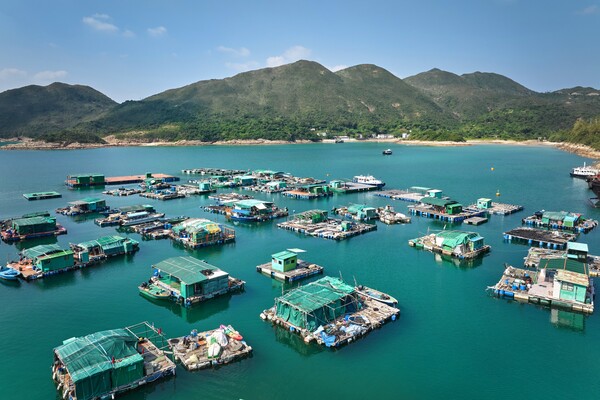High Island Exploration Made Easy

High Island, which is part of the Hong Kong UNESCO Global Geopark (Hong Kong Geopark), features diverse and breathtaking scenery and thanks to new ferry services and a recommended land route, visitors can thoroughly enjoy exploring this remarkable place.
Super volcano
High Island used to be the largest island in the Sai Kung area, but in 1969, two dams were built to connect it to the Sai Kung peninsula, forming the High Island Reservoir. It was once a huge volcano and its molten volcanic material was transformed into spectacular hexagonal rock formations. Such rock columns were selected as one of the First 100 International Union of Geological Sciences Geological Heritage Sites.
In addition, the Hakka and fishing villages scattered around the bay still retain their rustic charm, making it a green gem in the waters off Sai Kung.
High Island has four villages: Tung A, Pak A, Pak Lap and Sha Kiu. Tung A, Pak A and Pak Lap are Hakka villages, while Sha Kiu is a fishing village. In its peak in the 1950s and 1960s, there were about 500 Hakka residents and nearly 200 fishing boats anchored in the bay, with an estimated total of over 1,000 fishermen.
Easy access
Starting from November 11, people visiting the villages can enjoy the convenience of using ferry services that shuttle between Sai Kung and High Island. Plus, Hong Kong Geopark recommends a new land route for people who wish to explore High Island. The route from Pak A pier to Sha Kiu will take about two hours to complete. While walking along the route, people can visit Leung Shuen Wan Tin Hau Temple, a Grade III historic building dedicated to the ancient Chinese Goddess of the Sea.
Four treasures
The temple houses four treasures, including an ornate wood carving set that dates back to the Qing Dynasty, a dragon head wood carving, a dragon sedan chair, on which a statue of Tin Hau is placed during the Tin Hau Festival’s sea parade, and an ancient bell which was made in the sixth year of the Qianlong reign of the Qing dynasty.
Leung Shuen Wan fisherman representative Cheng King-man revealed more about the bell’s history by explaining that the temple acolyte would regularly ring the bell to alert fishermen to the time, during a time when watches or radios did not exist.
Village cultures
The Chinese name of High Island is Leung Shuen Wan, which loosely translated means food supply bay. In the old days, fishing boats came to the island to replenish their food and water. The name of the bay reflects its historical role as a shelter and supply station for ships.
Apart from describing High Island as a special place with stunning scenery, natural attractions and rich cultures, Agriculture, Fisheries & Conservation Department Senior Geopark Officer Chan Yu-nam pointed out that along the route from Pak A, via Tung A to Sha Kiu, visitors can discover natural attractions that comprise a mangrove habitat and a beach.
”Through the promotion of green tourism, we hope the culture and tradition of rural villages can be preserved and passed on,” Miss Chan added.
New Hub Helps Green Tech To Flourish
Last month, the Hong Kong Science & Technology Parks Corporation, or HKSTP, transformed its InnoCentre in Kowloon ... Read more
MICE Tourism Gains Momentum
Ballroom inspections and mahjong sessions may not be what automatically springs to mind when you consider Hong Kong’... Read more
Game Startups Reach New Level
The global video game industry is highly competitive, requiring effective marketing for success. The Hong Kong Game En... Read more
Breast Milk Donations Save Lives
Last April, Ida Chan welcomed her son into the world. He was born a kilogramme lighter than expected, and Ida decided ... Read more
HK Reaches For The Moon
The beauty and mystery of the Moon have captivated the human imagination for millennia. Channelling that fascination i... Read more
Creating Disability-inclusive Jobs
Nestled in the Museum of the War of Resistance & Coastal Defence, Madam Hong Cafe enjoys the spectacular views of ... Read more

